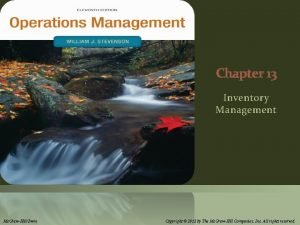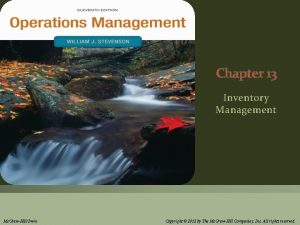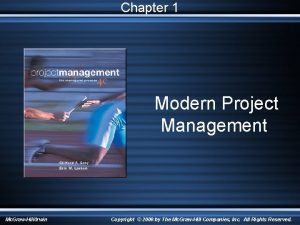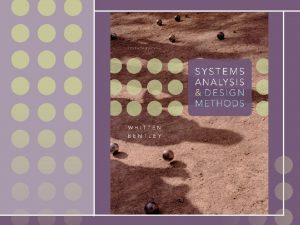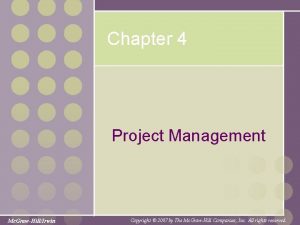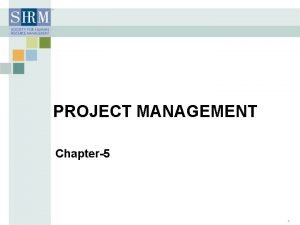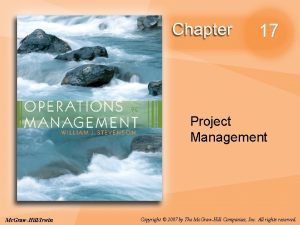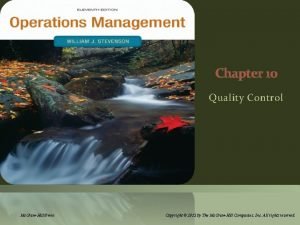Chapter 17 Project Management Mc GrawHillIrwin Copyright 2012















- Slides: 15

Chapter 17 Project Management Mc. Graw-Hill/Irwin Copyright © 2012 by The Mc. Graw-Hill Companies, Inc. All rights reserved.

Chapter 17: Learning Objectives You should be able to: 1. Discuss the behavioral aspects of projects in terms of project personnel and the project manager 2. Explain the nature and importance of a work breakdown structure in project management 3. Give a general description of PERT/CPM techniques 4. Construct simple network diagrams 5. List the kinds of information that a PERT or CPM analysis can provide 6. Analyze networks with deterministic times 7. Analyze networks with probabilistic times 8. Describe activity ‘crashing’ and solve typical problems Student Slides 17 -2

Projects Unique, one-time operations designed to accomplish a specific set of objectives in a limited time frame Examples: The Olympic Games Producing a movie Software development Product development ERP implementation Student Slides 17 -3

Work Breakdown Structure (WBS) WBS A hierarchical listing of what must be done during a project Establishes a logical framework for identifying the required activities for the project 1. 2. 3. Student Slides Identify the major elements of the project Identify the major supporting activities for each of the major elements Break down each major supporting activity into a list of the activities that will be needed to accomplish it 17 -4

PERT and CPM PERT (program evaluation and review technique) and CPM (critical path method) are two techniques used to manage large-scale projects By using PERT or CPM Managers can obtain: 1. 2. 3. 4. A graphical display of project activities An estimate of how long the project will take An indication of which activities are most critical to timely project completion An indication of how long any activity can be delayed without delaying the project Student Slides 17 -5

Network Diagram Network diagram Diagram of project activities that shows sequential relationships by use of arrows and nodes Activity on arrow (AOA) Network diagram convention in which arrows designate activities Activity on node (AON) Network convention in which nodes designate activities Activities Project steps that consume resources and/or time Events The starting and finishing of activities Student Slides 17 -6

Deterministic Time Estimates Deterministic Time estimates that are fairly certain Probabilistic Time estimates that allow for variation Student Slides 17 -7

Early Start, Early Finish Finding ES and EF involves a forward pass through the network diagram Early start (ES) The earliest time an activity can start Assumes all preceding activities start as early as possible For nodes with one entering arrow ES = EF of the entering arrow For activities leaving nodes with multiple entering arrows ES = the largest of the largest entering EF Early finish (EF) The earliest time an activity can finish EF = ES + t Student Slides 17 -8

Late Start, Late Finish Finding LS and LF involves a backward pass through the network diagram Late Start (LS) The latest time the activity can start and not delay the project The latest starting time for each activity is equal to its latest finishing time minus its expected duration: LS = LF - t Late Finish (LF) The latest time the activity can finish and not delay the project For nodes with one leaving arrow, LF for nodes entering that node equals the LS of the leaving arrow For nodes with multiple leaving arrows, LF for arrows entering node equals the smallest of the leaving arrows Student Slides 17 -9

Slack and the Critical Path Slack can be computed one of two ways: Slack = LS – ES Slack = LF – EF Critical path The critical path is indicated by the activities with zero slack Student Slides 17 -10

Probabilistic Time Estimates The beta distribution is generally used to describe the inherent variability in time estimates The probabilistic approach involves three time estimates: Optimistic time, (to) The length of time required under optimal conditions Pessimistic time, (tp) The length of time required under the worst conditions Most likely time, (tm) The most probable length of time required Student Slides 17 -11

Probabilistic Time Estimates The expected time, te , for an activity is a weighted average of the three time estimates: The expected duration of a path is equal to the sum of the expected times of the activities on that path: Student Slides 17 -12

Probabilistic Time Estimates The standard deviation of each activity’s time is estimated as one-sixth of the difference between the pessimistic and optimistic time estimates. The variance is the square of the standard deviation: Standard deviation of the expected time for the path Student Slides 17 -13

Project Completion Time A project is not complete until all project activities are complete It is risky to only consider the critical path when assessing the probability of completing a project within a specified time. To determine the probability of completing the project within a particular time frame Calculate the probability that each path in the project will be completed within the specified time Multiply these probabilities The result is the probability that the project will be completed within the specified time Student Slides 17 -14

Operations Strategy Projects present both strategic opportunities and risks It is critical to devote sufficient resources and attention to projects Projects are often employed in situations that are characterized by significant uncertainties that demand Careful planning Wise selection of project manager and team Monitoring of the project Project software can facilitate successful project completion Be careful to not focus on critical path activities to the exclusion of other activities that may become critical It is not uncommon for projects to fail When that happens, it can be beneficial to examine the probable reasons for failure Student Slides 17 -15
 Dentist copyright 2012
Dentist copyright 2012 Copyright 2012
Copyright 2012 Copyright 2012
Copyright 2012 Copyright 2012
Copyright 2012 Traditional vs modern project management
Traditional vs modern project management The role of project management in achieving project success
The role of project management in achieving project success Walker royce software project management
Walker royce software project management When reducing project duration
When reducing project duration Introduction to project management kathy schwalbe
Introduction to project management kathy schwalbe Software project evaluation
Software project evaluation Perpetual project closure
Perpetual project closure Ms project agile
Ms project agile Type n terminations
Type n terminations Brand positioning keller
Brand positioning keller Sql server management studio express 2005
Sql server management studio express 2005 Asset management vs project management
Asset management vs project management
















